DOWNLOAD MOBILE APPLICATION TO LEARN MORE: Aggregate Demand Aggregate Supply And Related Concepts Important Questions

DOWNLOAD MOBILE APPLICATION TO LEARN MORE: Aggregate Demand Aggregate Supply And Related Concepts Important Questions
Points to Remember
Aggregate Demand (AD) is the sum total of demand for all goods and services in the economy during the period of an accounting year. It is measured in terms of total (planned) expenditure on the goods and services in the economy during an accounting year.
Components:
AD = C + I + G + (X – M)
= Panned expenditure on the domestically produced goods and services during an accounting year.
Aggregate Supply (AS) refers to the production of goods and services in the economy as planned by the producers during an accounting year.
It is identical with GDP in the economy where: (i) prices are constant, and (ii) supply responds proportionately to increase in demand, owing to excess capacity. Being identical with GDP, it is indicated by a 45° line.
DOWNLOAD MOBILE APPLICATION TO LEARN MORE: Aggregate Demand Aggregate Supply And Related Concepts Important Questions
Consumption function is the functional relationship between consumption and income. It is specified as under:

Slope of C-line (consumption function) is the rate at which C (consumption) increases a response to a given increase in Y (income). It is measured as the ratio between additional consumption and additions income. Slope of C – function

Saving Function is the functional relationship between saving and income, it is usually specified as under :

Slope of S-line (saving function) is measured as the ratio between additional saving and additional income. Slope of S – function

Average Propensity to Consume is the ratio between total consumption and total income.

Average Propensity to Save is the ratio between total saving and total income.

Relationship between Propensity to Consume and Propensity to Save

DOWNLOAD MOBILE APPLICATION TO LEARN MORE: Aggregate Demand Aggregate Supply And Related Concepts Important Questions
Table of Contents
Aggregate Demand Aggregate Supply And Related Concepts Important Questions
Choose the correct option:
1. AD refers to
(a) demand for all goods and services produced in the economy during a period of one year
(b) total unplanned expenditure on the goods and services in the economy during year
(c) sum total of investment expenditure and saving in the economy during an accounting year
(d) all of these
DOWNLOAD MOBILE APPLICATION TO LEARN MORE: Aggregate Demand Aggregate Supply And Related Concepts Important Questions
2. In an open economy, aggregate demand is estimated as
(a) Private consumption expenditure
(b) Private consumption expenditure + Government expenditure
(c) Private investment expenditure + Private consumption expenditure + Government expenditure
(d) Private consumption expenditure + Private investment expenditure + Government expenditure + Net exports
3. Consumption function is a functional relationship between
(a) income and saving
(b) price and consumption
(c) consumption and income
(d) consumption and saving
4. Average propensity to consume is equal to :

5. Marginal propensity to consume is equal to:

DOWNLOAD MOBILE APPLICATION TO LEARN MORE: Aggregate Demand Aggregate Supply And Related Concepts Important Questions
6. MPC being equal to 0.5, what will be AC, if income increases by ?
(a) Rs. 60
(b) Rs. 50
(c) Rs. 40
(d) Rs. 70
7. If C = 450 and Y = 1.000 the average propensity to consume will be :
(a) 750
(b) 0.75
(c) 450
(d) 0.45
8. When S changes from-30 to-20, then ∆S is equal to:
(a) -10
(b) +10
(c) -20
(d) -30
9. Saving function is the functional relationship between
(a) income and consumption
(b) price and saving
(c) saving and income
(d) consumption and saving

(a) value of C when Y = 0
(b) value of C when V = C
(c) value of C when Y changes
(d) value of C when Y is constant
DOWNLOAD MOBILE APPLICATION TO LEARN MORE: Aggregate Demand Aggregate Supply And Related Concepts Important Questions
11. Average propensity to save is equal to

12. If MPS is 0.6, what will be AS when income increases by Rs. 50?
(a) Rs. 30
(b) Rs. 20
(c) Rs. 25
(d) Rs. 35
13. If MPC is 40 per cent, MPS will be:
(a) 70 per cent
(b) 60 per cent
(c) 50 per cent
(d) 40 per cent
14. If consumption function is C = bY, what will be the saving function?

15. Which of the following is correct?
(a) MPC + MPS = 1
(b) 1 – MPC = MPS
(c) 1 – MPS = MPC
(d) All of these
DOWNLOAD MOBILE APPLICATION TO LEARN MORE: Aggregate Demand Aggregate Supply And Related Concepts Important Questions
16. If MPC = 0.4 and Delta*Y = 81.00 what will be AS?
(a) Rs. 400
(b) Rs. 500
(c) Rs. 600
(d) Rs. 250
17. The slope of 5-line is indicated by:
(a) MPC
(b) MPS
(c) 1 – MPC
(d) both (b) and (c)
18. When C = 100 + 0.5Y and Y = 1, 200 autonomous consumption will be:
(a) 100
(b) 1,000
(c) 500
(d) 600
19. When C = 350 + 0.8Y and Y = 500, saving at zero income level will be:
(a) 300
(b) -300
(c) 1,100
(d) 800
20. Break-even point occurs when:
(a) Y = S
(b) S = 0
(c) Y = C
(d) both (b) and (c)
DOWNLOAD MOBILE APPLICATION TO LEARN MORE: Aggregate Demand Aggregate Supply And Related Concepts Important Questions
| 1. (a) | 11. (d) |
| 2. (d) | 12. (a) |
| 3. (c) | 13. (b) |
| 4. (c) | 14. (b) |
| 5. (c) | 15. (d) |
| 6. (b) | 16. (c) |
| 7. (d) | 17. (d) |
| 8. (b) | 18. (a) |
| 9. (c) | 19. (b) |
| 10. (a) | 20. (d) |
Matching the Correct Statements
I. From the set of statements given in Column I and Column II, choose the correct pair of statements
| Column I | Column II |
| (a) Aggregate demand | (i) A stock concept |
| (b) imports | (ii) Decreases AD in the domestic economy |
| (c) APC | (iii) Slope of Cline |
| (d) Aggregate supply | (iv) Actual production |
| (e) APS | (v) Can be greater than one |
Answer
(b) Imports-(i) Decreases AD in the domestic economy
II. Identify the correct sequence of alternatives given in Column II by matching them with respective items in Column 1:
| Column I | Column II |
| (a) AD curve | (i) Income-Consumption |
| (b) Saving | (ii) |
| (c) Net exports | (iii) Saving is zero |
| (d) Saving is zero | (iv) Diagrammatic presentation of AD schedule |
| (e) Y = C | (v) Exports-Imports |
Answers
(a) – (iv), (b) – (i), (c) – (v), (d) – (ii), (e) – (iii)
‘Very Short Answer’ Objective Type Questions
1. What is aggregate demand?
Ans. Aggregate demand is the total demand for goods and services in an economy, measured in terms of total expenditure.
2. Name the principal components of aggregate demand in an open economy.
Ans. The principal components of aggregate demand are: (i) Private consumption expenditure, (ii) Private investment expenditure, (iii) Government expenditure, and (iv) Net exports.
AD = C + I + G + (X – M)
3. Define aggregate demand schedule.
Ans. Aggregate demand schedule is a table showing AD (or aggregate expenditure) corresponding to different levels of income in the economy.
4. Define aggregate demand curve.
Ans. Aggregate demand (AD) curve is diagrammatic presentation of AD schedule, showing AD corresponding to different levels of Y (income) in the economy.
DOWNLOAD MOBILE APPLICATION TO LEARN MORE: Aggregate Demand Aggregate Supply And Related Concepts Important Questions
5. What is consumption function?
Ans. “Consumption function refers to the functional relationship between consumption (C) and income (Y)

6. What is meant by autonomous consumption?
Ans. Autonomous consumption refers to minimum level of consumption, even when income is zero.
7. What is a linear consumption function?
Ans. Linear consumption function is a straight line consumption function in which MPC remains constant.
8. What is break even point?
Ans. The point where total consumption is equal to the total income or the point where total saving is equal to zero is called break-even point.
9. Define propensity to consume.
Ans. Propensity to consume refers to the proportion of income used as consumption expenditure, it is measured as the ratio between C and Y.
10. What is average propensity to consume?
Ans. Average propensity to consume is the ratio of aggregate consumption expenditure to aggregate income.

DOWNLOAD MOBILE APPLICATION TO LEARN MORE: Aggregate Demand Aggregate Supply And Related Concepts Important Questions
13. Define propensity to save.
Ans. Propensity to save refers to the proportion of income which is kept as saving It is measured as the ratio between S and Y.
14. What is average propensity to save?
Ans. Average propensity to save is the ratio of aggregate saving to aggregate income
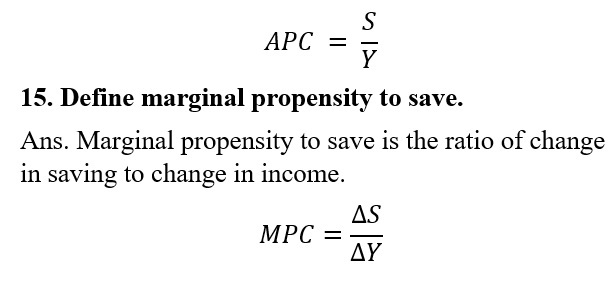
DOWNLOAD MOBILE APPLICATION TO LEARN MORE: Aggregate Demand Aggregate Supply And Related Concepts Important Questions
16. Why cannot the value of marginal propensity to consume be greater than one?
Ans. It is because change in consumption cannot be greater than change in income.
17. What is the relationship between marginal propensity to save and marginal propensity to consume?
Ans. Aggregate of marginal propensity to save and marginal propensity to consume is equal to one or
MPS + MPC = 1.
18. What is the value of marginal propensity to consume when marginal propensity to save is zero?
Ans. Value of marginal propensity to consume is 1 when marginal propensity to save is zero.
19. The disposable income is 1,000 crore and level of consumption is 800 crore. Calculate average propensity to consume.
Ans. Average propensity to consume

20. If average propensity to save is 0.6, how much will be average propensity to consume?
Ans. Average propensity to consume will be 0.4, as backslash APC + APS = 1.
21. If average propensity to consume is 0.7, how much will be average propensity to save?
Ans. Average propensity to save will be 0.3, since APC + APS = 1.
22. How much is the marginal propensity to consume in an economy in which marginal propensity to save is 0.2?
Ans. Marginal propensity to consume would be 0.8, since MPC + MPS = 1.
23. How much is the marginal propensity to save in an economy in which the marginal propensity to consume is 0.75?
Ans. Marginal propensity to save would be 0.25, since MPC + MPS = 1.
2. Reason-based Questions (Comprehension of the Subject-matter)
DOWNLOAD MOBILE APPLICATION TO LEARN MORE: Aggregate Demand Aggregate Supply And Related Concepts Important Questions
Read the following statements carefully. Write True or False with a reason.
1. MPC is the ratio between desired consumption and income, not the actual consumption and income.
Ans. True. MPC reflects what people wish to consume at different levels of income.
2. C is positively related to Y, but C is not zero when Y is zero.
Ans. True. C is positively related to Y, but C is not zero when Y is zero. Because, there is always some minimum level of C irrespective of level of Y.
3. C can exceed Y, but S cannot.
Ans. True. Because there is always some minimum level of C even when the level of Y is zero.
4. AD does not include exports.
Ans. False. AD includes exports. Because exports refer to demand for the domestically produced goods rest of the world.
5. Consumption never exceeds income.
Ans. False Consumption can be greater than income. There is always some minimum level of consumption even when income is zero.
6. Saving can never be negative.
Ans. False. Saving can be negative when consumption is greater than income. Negative saving amounts to borrowing.
7. Break-even point is struck when S = 0.
Ans. True. Break-even point is struck when S = 0. At break-even point, C = Y.
8. Average propensity to consume can never be greater than one.
Ans. False. Average propensity to consume can be greater than one when consumption is greater than income.
9. APC and MPC are never equal.
Ans. False. APC and MPC can be equal. When APC is constant, APC will be equal to MPC.
10. APC + APS = 1 .
Ans. True. We know that,

DOWNLOAD MOBILE APPLICATION TO LEARN MORE: Aggregate Demand Aggregate Supply And Related Concepts Important Questions
Ans. False MPC + MPS = 1, it can never be greater than or less than 1.
12. The rate at which increases always tends to be lower than the rate at which Y increases.
Ans. True The rate at which consumption (C) increases is often less than the rate at which income (Y) increases. This is in accordance with the Psychological Law of Consumption.
13. The rate at which 5 increases always tends to be greater than the rate at which Y increases.
Ans. False. Because any increase in Y is split into two parts (i) increase in C, and (ii) increase in S. Accordingly, the rate at which S increases (or C increases) must be lower than the rate at which Y increases.
14. The value of marginal propensity to save is always positive.
Ans. True Marginal propensity to save is the ratio between additional saving and additional income which is always positive because of positive relationship between saving and income.
15. Average propensity to save is never negative.
Ans. False Average propensity to save can be negative. It is negative in situations when saving is negative or when consumption is greater than income.
DOWNLOAD MOBILE APPLICATION TO LEARN MORE: Aggregate Demand Aggregate Supply And Related Concepts Important Questions
16. Value of average propensity to save is always greater than zero.
Ans. False. The value of average propensity to save (APS) can be less than zero it happens when consumption is greater than income or when APC > 1.
17. Negative value of average propensity to save always implies negative value of marginal propensity to save.
Ans. No, it is not true. The value of average propensity to save is negative when consumption is greater than income but this does not mean that marginal propensity to save (MPS) will also be negative. In fact MPS is never negative. Because it is the ratio between ∆S and ∆Y and ∆S can never be negative, as a component of ∆Y.
18. APC + MPC = 1.
Ans. False. Because, whereas APC is the ratio between total consumption and total income, MPC is the ratio between additional consumption and additional income.
19. Average propensity to save is always less than 1.
Ans. True The value of average propensity to save (APS) is always less than 1 Because a part of income (Y) must be consumed (C cannot be zero) implying that only a part of Y is saved Consequently, APS must always be less than 1.

DOWNLOAD MOBILE APPLICATION TO LEARN MORE: Aggregate Demand Aggregate Supply And Related Concepts Important Questions
Q. Would consumption function be linear in case MPC is constant? Give reason in support of your answer
Ans. Yes. Consumption function would be linear in case MPC is constant. Reason: Constant MPC implies that C-line is a straight line (because MPC is the slope of C-line). A straight line C-line means that the consumption function is linear.
Q. How would you specify the saving function, given the consumption function as under?
C = bY
Ans. S = (1 – b) Y. [Note: In the C-function, there is no constant term like
DOWNLOAD MOBILE APPLICATION TO LEARN MORE: Aggregate Demand Aggregate Supply And Related Concepts Important Questions
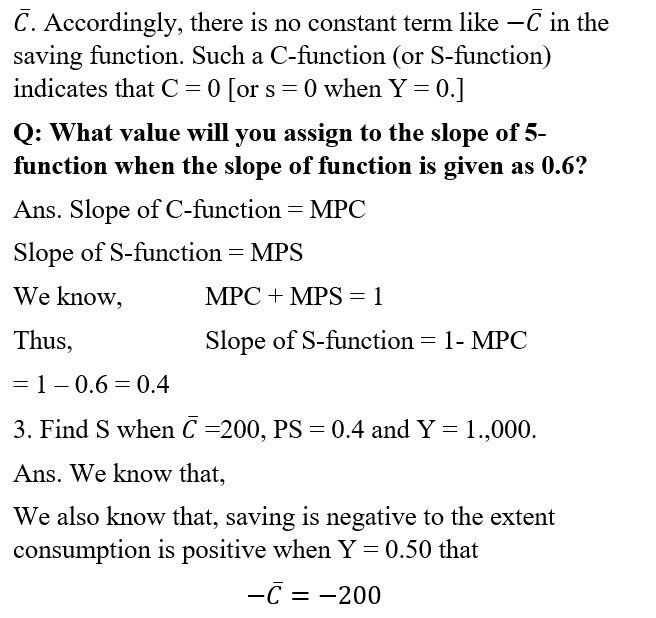
Substituting the given values, we get:
S = – 200 + 0.4 (1,000)
= – 200 + 400
=200.
Q. If personal disposable income is Rs. 1,000 crore and consumption expenditure is Rs. 750 crore, find out average propensity to save.
Ans. S = Y – C – Rs. 1,000 crore – Rs. 750 crore = Rs. 250 crore

= 0.25
Q. Can APS ever be negative? If yes, give an example.
Ans. Yes. APS can be negative in situations when S is negative (or when C > Y).
Example: Y = 50, C = 60, S = – 10
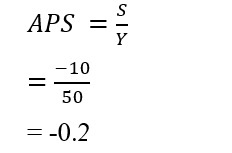
DOWNLOAD MOBILE APPLICATION TO LEARN MORE: Aggregate Demand Aggregate Supply And Related Concepts Important Questions
Q. APC and MPC are two parameters. The value of which parameter can be greater than one, and when? Ans. Value of APC can be greater than one. It happens when the level of income is low and C >Y. Value of MPC cannot be greater than one. MPC is the ratio between additional consumption and additional income

Q. Can MPS or MPC ever be negative? Give reasons in support of your answer. Ans. No. Neither MPS nor MPC can ever be negative. Because: MPS is the ratio between additional saving

which is always positive (because of positive relationship between C and Y)
DOWNLOAD MOBILE APPLICATION TO LEARN MORE: Aggregate Demand Aggregate Supply And Related Concepts Important Questions
HOTS & Applications
1. Do you agree that MPS cannot negative, but APS can be?
Ans. Given the fact that there is a positive relationship between saving and income, an increase in income must cause an increase in saving. Implying that MPS must always be positive. However, APS can be negative when at a very low level of income consumption is greater than income so that saving is negative.
2. The sum total of APC and APS is always equal to one, even when APC > 1. Is it true?
Ans. Yes. APC + APS = 1, even when APC > 1. Because consumption and saving are the only two components of income.
3. Do you think higher the level of Y, higher should be the level of autonomous consumption in C-function?
Ans. This is not correct because autonomous consumption is not related to the level of Y.
4. Increase in MPC implies increase in the slope of C-function. Comment.
Ans. The given statement is correct. Because MPC shows the rate at which consumption increases in response to increase in income. Or, MPC is the slope of C-function.
5. If APC is constant, C and Y should also be constant. Defend or refute.

6. What is aggregate demand? How it is different from market demand?
Ans. Aggregate demand refers to demand for all goods and services in the economy. It is measured in terms of total expenditure on goods and services produced in the economy during an accounting year. Whereas market demand is the sum total of demand for one commodity by all the buyers in the market.
Market demand is a micro concept while aggregate demand is a macro concept.
DOWNLOAD MOBILE APPLICATION TO LEARN MORE: Aggregate Demand Aggregate Supply And Related Concepts Important Questions
7. Complete the following table:
| Income | Saving | Marginal Propensity to Consume | Average Propensity to Consume |
| 0 50 100 150 200 | -20 -10 0 30 60 | ___________ | ___________ |
Ans.

8. Complete the following table:
| Income | Saving | Marginal Propensity to Consume | Average Propensity to Consume |
| 0 50 100 150 | 15 50 85 120 |
Ans.
DOWNLOAD MOBILE APPLICATION TO LEARN MORE: Aggregate Demand Aggregate Supply And Related Concepts Important Questions
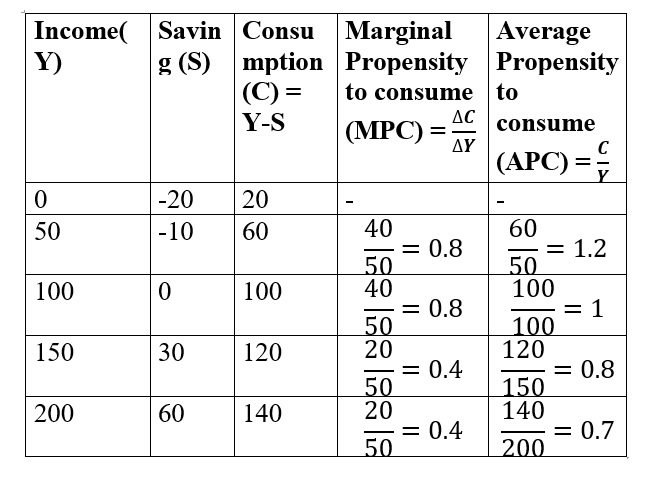
9. Complete the following table:
| Income | Saving | Marginal Propensity to Consume | Average Propensity to Consume |
| 0 100 200 300 | – 0.75 0.75 0.75 | -30 __________ | ____ |
Ans.
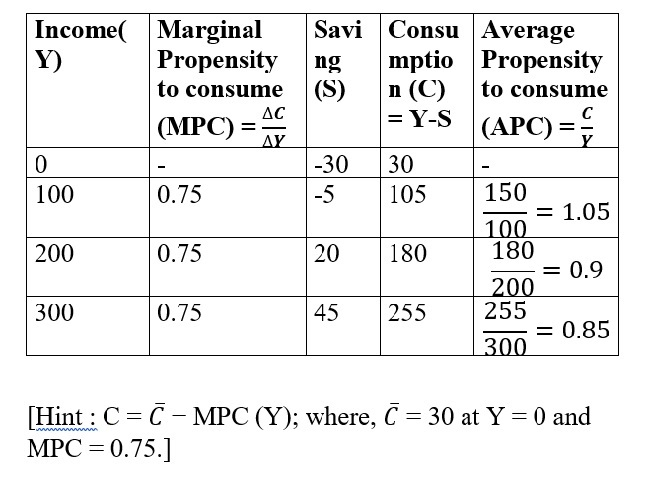
DOWNLOAD MOBILE APPLICATION TO LEARN MORE: Aggregate Demand Aggregate Supply And Related Concepts Important Questions
10. Given below is the consumption function in an economy:
C = 100 + 0.5Y
With the help of a numerical examples show that in this economy as income increase APC will decrease.
Ans. Given consumption function is,
C = 100 + 0.5Y
C = 100
When Y = 0,

We find that as income in the economy increases, APC will decrease.
DOWNLOAD MOBILE APPLICATION TO LEARN MORE: Aggregate Demand Aggregate Supply And Related Concepts Important Questions
11. Find autonomous consumption and total consumption when saving function is S = -100 + 0.5Y and Y = 1, 500.
Ans. Given.
S = -100 + 0.5Y

Autonomous consumption = 100
Total consumption = 850.
DOWNLOAD MOBILE APPLICATION TO LEARN MORE: Aggregate Demand Aggregate Supply And Related Concepts Important Questions
12. Find consumption and saving when C = 100, MPC = 0.5 and Y = 2,000. Is there greater increase in income as compared to consumption when income changes to 2,500?
Ans. We know that,
C = C + MPC (Y)
When Y = 2,000, C = 100 + 0.5 (2,000)
= 100 + 1,000
= 1,100
We also know that,
Or, Y = C + S
S = Y – C
= 2,000 – 1,100
= 900
Consumption = 1,100
Saving = 900
When Y = 2,500
C = 100 + 0.5 (2,500)
= 100 + 1,250
=1,350
Change in C = 1,350 – 1,100 = 250
Change in Y = 2,500 – 2, 000 = 500
Yes, the increase in income is grater than the increase in consumption when Y increases from 2,000 to 2,500.
DOWNLOAD MOBILE APPLICATION TO LEARN MORE: Aggregate Demand Aggregate Supply And Related Concepts Important Questions
13. At what rate consumption is increasing in the economy when MPS = 0.5, and autonomous consumption is zero ? Draw a diagram.
Ans. MPC + MPS = 1
MPC = 1 – MPS
= 1 – 0.5
= 0.5
MPC (0.5) indicates the rate at which consumption increases in response to increase in income.
14. Find change in savings when 2/3rd of income is always spent as consumption expenditure and current income is 50% more than the initial income of Rs. 50,000.
Ans. Current income = 50% Rs. 50,000 + Rs. 50, 000
= Rs. 25,000 + Rs. 50,000
= Rs. 75,000
Initial income = Rs. 50,000
Change in income (∆Y) = Rs. 75,000 – Rs. 50,000
= Rs. 25,000
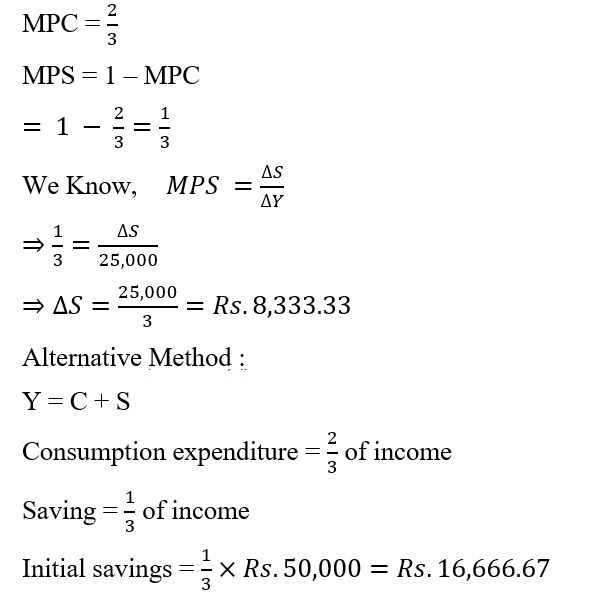

DOWNLOAD MOBILE APPLICATION TO LEARN MORE: Aggregate Demand Aggregate Supply And Related Concepts Important Questions
15. Complete the following table:
| Income | Average Propensity to Consume | Saving | Marginal Propensity to Consume |
| 0 100 200 300 | – 1.6 1 0.8 | -80 | ____ |
Ans.
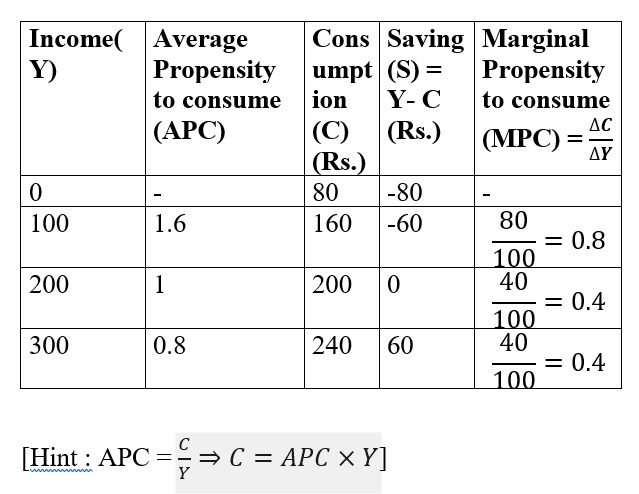
16. The exports fall 15% to 1718.07 cr. in first 6 months of FY 15.
How will this affect aggregate demand in the economy?
Ans. Fall in exports would be reflected as a fall in aggregate demand. Because, exports are a component of aggregate demand.
17. Do you think increase in MPS should be beneficial to the growth of GDP in India?
Ans. Increase in MPs implies that people start saving more when their income rises. This is good for the GDP growth, provided people put their savings in the banks and the banks are able to convert savings into investment (by way of loans to the investors). However, in countries like India where banking habits of the people are yet not grown, savings may remain as die cash balances with the people. Implying that additional income of the people is not converted into additional demand. This may cause deficiency of AD. Deficient AD may lead to economic slowdown (state of recession in the economy).
DOWNLOAD MOBILE APPLICATION TO LEARN MORE: Aggregate Demand Aggregate Supply And Related Concepts Important Questions
Analysis & Evaluation based Questions
1. Why should rising MPS be a cause of worry when it is a sign of rising GDP in the economy?
Ans. Ring MPS implies falling MPC, as MPS MPC 1. It indicates that lesser and lesser proportion of the additional income goes to consumption expenditure Implying a gradual shrinkage of AD (aggregate demand) in relation to Y (income). In such a situation, the economy might slip into a state of recession or economic slowdown.
2. In India propensity to consume is fairly high. Why is it that the manufacturing sector in India shows a low rate of growth because of low demand?
Ans. High propensity to consume in India is primarily because of low income of the people. When income is low, the bulk of it is used as expenditure on food and allied items. Having spent the bulk of their income on food (and related items), the people have limited capacity to buy manufactured goods. Thus, demand for manufactured goods remains low. Which is why manufacturing sector show a low rate of growth.
DOWNLOAD MOBILE APPLICATION TO LEARN MORE: Aggregate Demand Aggregate Supply And Related Concepts Important Questions
DOWNLOAD MOBILE APPLICATION TO LEARN MORE: Aggregate Demand Aggregate Supply And Related Concepts Important Questions
ALSO VISIT : Economic Data of India
DOWNLOAD MOBILE APPLICATION TO LEARN MORE: Aggregate Demand Aggregate Supply And Related Concepts Important Questions
